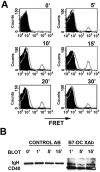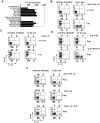Indirect recruitment of a CD40 signaling pathway in dendritic cells by B7-DC cross-linking antibody modulates T cell functions
- PMID: 19399172
- PMCID: PMC2670496
- DOI: 10.1371/journal.pone.0005373
Indirect recruitment of a CD40 signaling pathway in dendritic cells by B7-DC cross-linking antibody modulates T cell functions
Retraction in
-
Retraction: Indirect recruitment of a CD40 signaling pathway in dendritic cells by B7-DC cross-linking antibody modulates T cell functions.PLoS One. 2010 Mar 3;5(3):10.1371/annotation/36ac4b2c-cf27-41d9-90e2-e5d58d307896. doi: 10.1371/annotation/36ac4b2c-cf27-41d9-90e2-e5d58d307896. PLoS One. 2010. PMID: 20221242 Free PMC article. No abstract available.
Abstract
The human IgM B7-DC XAb protects mice from tumors in both therapeutic and prophylactic settings. Its mechanism of action is mediated by its binding to B7-DC/PD-L2 molecules on the surface of dendritic cells (DCs) to induce a multimolecular cap and subsequent activation of signaling cascades that determine a unique combination of DC phenotypes. One such phenotype, the B7-DC XAb-induced antigen accumulation in mTLR-matured DCs, has been linked to signaling through TREM-2, but the signals required for other DC phenotypes critical for the therapeutic effects in animal models remain unclear. Here, FRET and co-immunoprecipitation studies show that CD40 is recruited to the multi-molecular complex by B7-DC XAb. Signals emanating from CD40 are important, as CD40(-/-) DCs treated with B7-DC XAb (DC(XAb)) activated DAP12, but failed to activate NFkappaB, and were not protected from cell death upon cytokine withdrawal or treatment with Vitamin D(3). CD40(-/-) DC(XAb) also failed to secrete IL-6 and were unable to support the conversion of T regulatory cells into IL-17+ effector T cells in vitro. Importantly, the expression of CD40 was required for the overall ability of B7-DC XAb to induce anti-tumor CTL, to provide protection from a number of tumor types, and for DC(XAb) to be effective anti-tumor vaccines in vivo. These results indicate that B7-DC XAb modulation of DC phenotypes is through its ability to indirectly recruit common signaling molecules and elements of their endogenous signaling pathways through targeted binding to a cell-specific surface determinant.
Conflict of interest statement
Figures




References
-
- Radhakrishnan S, Nguyen LT, Ciric B, Ure DR, Zhou B, et al. Naturally occurring human IgM antibody that binds B7-DC and potentiates T cell stimulation by dendritic cells. J Immunol. 2003;170:1830–1838. - PubMed
-
- Pavelko KD, Heckman KL, Hansen MJ, Pease LR. An effective vaccine strategy protective against antigenically distinct tumor variants. Cancer Res. 2008;68:2471–2478. - PubMed
Publication types
MeSH terms
Substances
Grants and funding
LinkOut - more resources
Full Text Sources
Other Literature Sources
Research Materials
Miscellaneous

